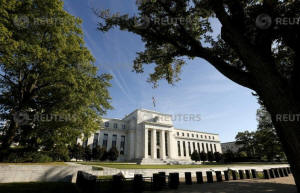U.S. job growth soars; annual wage gain largest since
2009
 Send a link to a friend
Send a link to a friend
 [November 03, 2018]
By Lucia Mutikani [November 03, 2018]
By Lucia Mutikani
WASHINGTON (Reuters) - U.S. job growth
rebounded sharply in October and wages recorded their largest annual
gain in 9-1/2 years, pointing to further labor market tightening that
could encourage the Federal Reserve to raise interest rates again in
December.
The Labor Department's closely watched monthly employment report on
Friday also showed the unemployment rate was steady at a 49-year low of
3.7 percent as 711,000 people entered the labor force, in a sign of
confidence in the jobs market.
Sustained labor market strength eased fears about the economy's health
following weak housing and business spending data. President Donald
Trump cheered the robust jobs report, which came less than a week before
the midterm elections that will decide who controls the U.S. Congress.
"These are incredible numbers," Trump tweeted.
Nonfarm payrolls increased by 250,000 jobs last month as employment in
the leisure and hospitality sector bounced back after being held down by
Hurricane Florence, which drenched North and South Carolina in
mid-September.
There were also big gains in construction, professional and business
services payrolls, and manufacturing, where employment increased by the
most in 10 months.
The economy created 118,000 jobs in September.

Economists polled by Reuters had forecast payrolls would increase by
190,000 jobs in October and the unemployment rate would be unchanged at
3.7 percent. The Labor Department said Hurricane Michael, which struck
the Florida Panhandle in mid-October, "had no discernible effect on the
national employment and unemployment estimates for October."
Average hourly earnings rose five cents, or 0.2 percent, in October
after advancing 0.3 percent in September. That boosted the annual
increase in wages to 3.1 percent, the biggest gain since April 2009,
from 2.8 percent in September.
Employers also increased hours for workers last month. The average
workweek rose to 34.5 hours from 34.4 hours in September.
"The report shows a booming U.S. economy with a sufficient whiff of wage
inflation to keep the Fed on track to raise rates in December and at
least twice next year," said David Kelly, chief global strategist at
JPMorgan Funds in New York.
The dollar <.DXY> was trading higher against a basket of currencies.
Stocks on Wall Street fell while U.S. Treasury yields rose.
Strong annual wage growth mirrors other data published this week showing
wages and salaries rising in the third quarter by the most since
mid-2008. Hourly compensation also increased at a brisk pace in the
third quarter.
Firming wages support the view that inflation will hover around the
Fed's 2.0 percent target for a while. The personal consumption
expenditures price index excluding the volatile food and energy
components, which is the Fed's preferred inflation measure, has
increased by 2.0 percent for five straight months.
GRAPHIC: U.S. wage growth - https://tmsnrt.rs/2CVLTHg
MODESTLY INFLATIONARY
The Fed is not expected to raise rates at its policy meeting next week,
but economists believe October's strong labor market data could see the
U.S. central bank signal an increase in December. The Fed raised
borrowing costs in September for the third time this year.
Some economists said Fed officials were likely to view the low
unemployment and rising wages as modestly inflationary.
[to top of second column] |

The Federal Reserve headquarters in Washington September 16 2015.
REUTERS/Kevin Lamarque/File Photo/File Photo/File Photo

"The risk in 2019 is that the Fed will increase the pace of rate hikes," said
Joe Brusuelas, chief economist at RSM in New York. "Market participants will
likely need to adjust their expectations going forward."
Employers, scrambling to find qualified workers, are boosting wages. There are a
record 7.14 million open jobs.
Online retail giant Amazon.com Inc <AMZN.O> announced last month it would raise
its minimum wage to $15 per hour for U.S. employees starting in November.
Workers at United States Steel Corp <X.N> are set to receive a hefty pay rise
also.
Employment gains averaged 218,000 jobs per month over the past three months,
double the roughly 100,000 needed to keep up with growth in the working-age
population.
That is seen supporting the economy through at least early 2019 when gross
domestic product is expected to significantly slow as the stimulus from the
Trump administration's $1.5 trillion tax cut package fades.
The labor force participation rate, or the proportion of working-age Americans
who have a job or are looking for one, rose to 62.9 percent last month from 62.7
percent in September.
A broader measure of unemployment, which includes people who want to work but
have given up searching and those working part-time because they cannot find
full-time employment, fell one-tenth of a percentage point to 7.4 percent,
matching a 17-year low hit in August.
The employment-to-population ratio rose to 60.6 percent, the highest since
January 2009, from 60.4 in September.
Last month, employment in the leisure and hospitality sector increased by 42,000
jobs after being unchanged in September. Retail payrolls rose by only 2,400 amid
declines in employment at gasoline stations and sporting goods and music stores.
Construction companies hired 30,000 more workers in October. Jobs in the sector
have been increasing despite weakness in the housing market. Government payrolls
rose by 4,000 jobs.

Manufacturing employment increased by 32,000 jobs in October after adding 18,000
positions in September. So far, hiring in the manufacturing sector does not
appear to have been affected by the White House's protectionist trade policy,
which has contributed to capacity constraints at factories.
The United States is locked in a bitter trade war with China that has led to
tit-for-tat tariffs. Washington also has imposed tariffs on products from other
trading partners, including the European Union, Canada and Mexico, prompting
retaliation.
Despite the protectionist measures, the trade deficit continues to deteriorate.
In a separate report on Friday, the Commerce Department said the trade gap
increased 1.3 percent to $54.0 billion in September, widening for a fourth
straight month.
"Tariffs have done little to dent America's appetite for imports," said Emily
Mandel, an economist at Moody's Analytics in West Chester, Pennsylvania. "The
trade deficit will remain a drag on the economy."
(Reporting by Lucia Mutikani; Editing by Clive McKeef and Paul Simao)
[© 2018 Thomson Reuters. All rights
reserved.] Copyright 2018 Reuters. All rights reserved. This material may not be published,
broadcast, rewritten or redistributed.
Thompson Reuters is solely responsible for this content. |